A Review of Bonding Immiscible Mg/Steel Dissimilar Metals
Abstract
:1. Introduction
1.1. Background
1.2. The Challenge of Mg/Steel Welding
1.3. Research Status and Progress
2. Solid State Processes
2.1. Friction Stir Welding
2.2. Diffusion Bonding
3. Welding-Brazing
3.1. Laser Welding-Brazing
3.1.1. Laser Welding without Any Filler Wire or Interlayer and Coatings
3.1.2. Laser Welding with Filler Wire or Interlayer and Coatings
3.2. Arc Welding-Brazing
3.2.1. Metal Inert-Gas Welding-Brazing
3.2.2. Cold Metal Transfer Welding-Brazing
3.3. Hybrid Heat Source Welding-Brazing
4. Fusion Welding
4.1. Laser-Arc Hybrid Heat Source Lap Welding
4.2. Laser-Arc Hybrid Heat Source Butt Welding
5. Other Processes
5.1. Resistance Spot Welding
5.2. Ultrasonic Spot Welding
6. Summary
Author Contributions
Funding
Conflicts of Interest
References
- Taban, E.; Gould, J.E.; Lippold, J.C. Dissimilar friction welding of 6061-T6 aluminum and AISI 1018 steel: Properties and microstructural characterization. Mater. Des. 2010, 31, 2305–2311. [Google Scholar] [CrossRef]
- Chen, Y.C.; Nakata, K. Friction stir lap joining aluminum and magnesium alloys. Scr. Mater. 2008, 58, 433–436. [Google Scholar] [CrossRef]
- Ouyang, J.H.; Yarrapareddy, E.; Kovacevic, R. Microstructural evolution in the friction stir welded 6061 aluminum alloy (T6-temper condition) to copper. J. Mater. Process. Technol. 2006, 172, 110–122. [Google Scholar] [CrossRef]
- Fronczek, D.M.; Wojewoda-Budka, J.; Chulist, R.; Sypien, A.; Korneva, A.; Szulc, Z.; Schell, N.; Zieba, P. Structural properties of Ti/Al clads manufactured by explosive welding and annealing. Mater. Des. 2016, 91, 80–89. [Google Scholar] [CrossRef]
- Gao, M.; Mei, S.W.; Wang, Z.M.; Li, X.Y.; Zeng, X.Y. Characterisation of laser welded dissimilar Ti/steel joint using Mg interlayer. Sci. Technol. Weld. Join. 2012, 17, 269–276. [Google Scholar] [CrossRef]
- Tan, C.; Yang, J.; Zhao, X.; Zhang, K.; Song, X.; Chen, B.; Li, L.; Feng, J. Influence of Ni coating on interfacial reactions and mechanical properties in laser welding-brazing of Mg/Ti butt joint. J. Alloys Compd. 2018, 764, 186–201. [Google Scholar] [CrossRef]
- Li, L.Q.; Tan, C.W.; Chen, Y.B.; Guo, W.; Hu, X.B. Influence of Zn coating on interfacial reactions and mechanical properties during laser welding-brazing of Mg to steel. Metall. Mater. Trans. A 2012, 43, 4740–4754. [Google Scholar] [CrossRef]
- Liu, L.; Ren, D.; Liu, F. A review of dissimilar welding techniques for magnesium alloys to aluminum alloys. Materials 2014, 7, 3735–3757. [Google Scholar] [CrossRef]
- Aizawa, T.; Hasehira, K.I.; Nishimura, C. Solid state synthesis of non-equilibrium phase in Mg-Co and Mg-Fe systems via bulk mechanical alloying. Mater. Trans. 2003, 44, 601–610. [Google Scholar] [CrossRef]
- Xu, R.Z.; Ni, D.R.; Yang, Q.; Xiao, B.L.; Liu, C.Z.; Ma, Z.Y. Influencing mechanism of Al-containing Zn coating on interfacial microstructure and mechanical properties of friction stir spot welded Mg-steel joint. Mater. Charact. 2018, 140, 197–206. [Google Scholar] [CrossRef]
- Liu, X.; Wang, X.; Wang, B.; Zhang, L.; Yang, C.; Chai, T. The role of mechanical connection during friction stir keyholeless spot welding joints of dissimilar materials. Metals 2017, 7, 217. [Google Scholar] [CrossRef]
- Chen, Y.; Chen, J.; Amirkhiz, B.S.; Worswick, M.J.; Gerlich, A.P. Microstructures and properties of Mg alloy/DP600 steel dissimilar refill friction stir spot welds. Sci. Technol. Weld. Join. 2015, 20, 494–501. [Google Scholar] [CrossRef]
- Zhang, Z.K.; Wang, X.J.; Wang, P.C.; Zhao, G. Friction stir keyholeless spot welding of AZ31 Mg alloy-mild steel. Trans. Nonferrous Met. Soc. China 2014, 24, 1709–1716. [Google Scholar] [CrossRef]
- Shen, Z.; Ding, Y.; Chen, J.; Gerlich, A.P. Comparison of fatigue behavior in Mg/Mg similar and Mg/steel dissimilar refill friction stir spot welds. Int. J. Fatigue 2016, 92, 78–86. [Google Scholar] [CrossRef]
- Jana, S.; Hovanski, Y.; Grant, G.J. Friction stir lap welding of magnesium alloy to steel: A preliminary investigation. Metall. Mater. Trans. A 2010, 41, 3173–3182. [Google Scholar] [CrossRef]
- Wei, Y.; Li, J.; Xiong, J.; Huang, F.; Zhang, F. Microstructures and mechanical properties of magnesium alloy and stainless steel weld-joint made by friction stir lap welding. Mater. Des. 2012, 33, 111–114. [Google Scholar] [CrossRef]
- Chen, Y.C.; Nakata, K. Effect of tool geometry on microstructure and mechanical properties of friction stir lap welded magnesium alloy and steel. Mater. Des. 2009, 30, 3913–3919. [Google Scholar] [CrossRef]
- Chen, Y.C.; Nakata, K. Friction stir lap welding of magnesium alloy and Zinc-coated steel. Mater. Trans. 2009, 50, 2598–2603. [Google Scholar] [CrossRef]
- Chen, Y.C.; Nakata, K. Effect of surface states of steel on microstructure and mechanical properties of lap joints of magnesium alloy and steel by friction stir welding. Sci. Technol. Weld. Join. 2010, 15, 293–298. [Google Scholar] [CrossRef]
- Schneider, C.; Weinberger, T.; Inoue, J.; Koseki, T.; Enzinger, N. Characterisation of interface of steel/magnesium FSW. Sci. Technol. Weld. Join. 2011, 16, 100–106. [Google Scholar] [CrossRef]
- Lee, C.Y.; Choi, D.H.; Yeon, Y.M.; Jung, S.B. Dissimilar friction stir spot welding of low carbon steel and Al-Mg alloy by formation of IMCs. Sci. Technol. Weld. Join. 2009, 14, 216–220. [Google Scholar] [CrossRef]
- Kasai, H.; Morisada, Y.; Fujii, H. Dissimilar FSW of immiscible materials: Steel/magnesium. Mater. Sci. Eng. A 2015, 624, 250–255. [Google Scholar] [CrossRef] [Green Version]
- Joo, S. Joining of dissimilar AZ31B magnesium alloy and SS400 mild steel by hybrid gas tungsten arc friction stir welding. Met. Mater. Int. 2013, 19, 1251–1257. [Google Scholar] [CrossRef]
- Liyanage, T.; Kilbourne, J.; Gerlich, A.P.; North, T.H. Joint formation in dissimilar Al alloy/steel and Mg alloy/steel friction stir spot welds. Sci. Technol. Weld. Join. 2009, 14, 500–508. [Google Scholar] [CrossRef]
- Wang, X.J.; Li, W.H.; Zhao, G. Connection mechanism research on friction stir spot welding without keyhole between magnesium and steel dissimilar alloys. Mater. Res. Innovations 2014, 18. [Google Scholar] [CrossRef]
- Uematsu, Y.; Kakiuchi, T.; Tozaki, Y.; Kojin, H. Comparative study of fatigue behaviour in dissimilar Al alloy/steel and Mg alloy/steel friction stir spot welds fabricated by scroll grooved tool without probe. Sci. Technol. Weld. Join. 2012, 17, 348–356. [Google Scholar] [CrossRef]
- Elthalabawy, W.M.; Khan, T.I. Microstructural development of diffusion-brazed austenitic stainless steel to magnesium alloy using a nickel interlayer. Mater. Charact. 2010, 61, 703–712, 1063–1066. [Google Scholar] [CrossRef]
- Elthalabawy, W.; Khant, T. Liquid phase bonding of 316L stainless steel to AZ31 magnesium alloy. J. Mater. Sci. Technol. 2011, 27, 22–28. [Google Scholar] [CrossRef]
- Elthalabawy, W.M.; Khan, T.I. Eutectic bonding of austenitic stainless steel 316L to magnesium alloy AZ31 using copper interlayer. Int. J. Adv. Manuf. Technol. 2011, 55, 235–241. [Google Scholar] [CrossRef]
- Yuan, X.J.; Sheng, G.M.; Luo, J.; Li, J. Microstructural characteristics of joint region during diffusion-brazing of magnesium alloy and stainless steel using pure copper interlayer. Trans. Nonferrous Met. Soc. China 2013, 23, 599–604. [Google Scholar] [CrossRef]
- Miao, Y.G.; Han, D.F.; Yao, J.Z.; Li, F. Microstructure and interface characteristics of laser penetration brazed magnesium alloy and steel. Sci. Technol. Weld. Join. 2010, 15, 97–103. [Google Scholar] [CrossRef]
- Miao, Y.G.; Han, D.F.; Yao, J.Z.; Li, F. Effect of laser offsets on joint performance of laser penetration brazing for magnesium alloy and steel. Mater. Des. 2010, 31, 3121–3126. [Google Scholar] [CrossRef]
- Miao, Y.; Han, D.; Xu, X.; Wu, B. Phase constitution in the interfacial region of laser penetration brazed magnesium–steel joints. Mater. Charact. 2014, 93, 87–93. [Google Scholar] [CrossRef]
- Jiang, M.; Gao, M.; Li, G.; Zhang, C.; Zeng, X.Y. Research on laser welding-brazing of dissimilar Mg alloy and stainless steel. Kovove Mater. 2014, 52, 11–17. [Google Scholar] [CrossRef]
- Casalino, G.; Guglielmi, P.; Lorusso, V.D.; Mortello, M.; Peyre, P.; Sorgente, D. Laser offset welding of AZ31B magnesium alloy to 316 stainless steel. J. Mater. Process. Technol. 2017, 242, 49–59. [Google Scholar] [CrossRef] [Green Version]
- Nasiri, A.M.; Zhou, Y. Effect of Zn interlayer on brazeability of AZ31B-Mg alloy to steel sheet. Sci. Technol. Weld. Join. 2015, 20, 155–163. [Google Scholar] [CrossRef]
- Li, L.Q.; Tan, C.W.; Chen, Y.B.; Guo, W.; Mei, C.X. CO2 laser welding-brazing characteristics of dissimilar metals AZ31B Mg alloy to Zn coated dual phase steel with Mg based filler. J. Mater. Process. Technol. 2013, 213, 361–375. [Google Scholar] [CrossRef]
- Tan, C.W.; Chen, Y.B.; Li, L.Q.; Guo, W. Comparative study of microstructure and mechanical properties of laser welded-brazed Mg/steel joints with four different coating surfaces. Sci. Technol. Weld. Join. 2013, 18, 466–472. [Google Scholar] [CrossRef]
- Tan, C.W.; Li, L.Q.; Chen, Y.B.; Mei, C.X.; Guo, W. Interfacial microstructure and fracture behavior of laser welded-brazed Mg alloys to Zn-coated steel. Int. J. Adv. Manuf. Technol. 2013, 68, 1179–1188. [Google Scholar] [CrossRef]
- Wahba, M.; Katayama, S. Laser welding of AZ31B magnesium alloy to Zn-coated steel. Mater. Des. 2012, 35, 701–706. [Google Scholar] [CrossRef]
- Tan, C.W.; Xiao, L.Y.; Liu, F.Y.; Chen, B.; Song, X.G.; Li, L.Q.; Feng, J.C. Influence of laser power on the microstructure and mechanical properties of a laser welded-brazed Mg alloy/Ni-coated steel dissimilar joint. J. Mater. Eng. Perform. 2017, 26, 2983–2997. [Google Scholar] [CrossRef]
- Interfacial Microstructure of Diode Laser Brazed AZ31B Magnesium to Steel Sheet Using a Nickel Interlayer. Available online: https://app.aws.org/wj/supplement/WJ_2013_01_s1.pdf (accessed on 29 September 2018).
- Nasiri, A.M.; Chartrand, P.; Weckman, D.C.; Zhou, N.Y. Thermochemical analysis of phases formed at the interface of a Mg alloy-Ni-plated steel joint during laser brazing. Metall. Mater. Trans. A 2013, 44, 1937–1946. [Google Scholar] [CrossRef]
- Influence of Al Interlayer Thickness on Laser Welding of Mg/Steel. Available online: http://s3.amazonaws.com/WJ-www.aws.org/supplement/WJ_2016_10_s384.pdf (accessed on 29 September 2018).
- Interfacial Microstructure of Laser Brazed AZ31B Magnesium to Sn-Plated Steel Sheet. Available online: https://app.aws.org/wj/supplement/WJ_2015_03_s61.pdf (accessed on 29 September 2018).
- Tan, C.W.; Song, X.G.; Meng, S.H.; Chen, B.; Li, L.Q.; Feng, J.C. Laser welding-brazing of Mg to stainless steel: Joining characteristics, interfacial microstructure, and mechanical properties. Int. J. Adv. Manuf. Technol. 2016, 86, 203–213. [Google Scholar] [CrossRef]
- Microstructural Characteristics and Mechanical Properties of Fiber Laser Welded-Brazed Mg Alloy-Stainless Steel Joint. Available online: https://s3.amazonaws.com/WJ-www.aws.org/supplement/WJ_2014_10_s399.pdf (accessed on 29 September 2018).
- Li, L.; Tan, C.; Chen, Y.; Guo, W.; Song, F. Comparative study on microstructure and mechanical properties of laser welded–brazed Mg/mild steel and Mg/stainless steel joints. Mater. Des. 2013, 43, 59–65. [Google Scholar] [CrossRef]
- Microstructure and Properties of Laser Brazed Magnesium to Coated Steel. Available online: https://uwaterloo.ca/centre-advanced-materials-joining/sites/ca.centre-advanced-materials joining/files/uploads/files/wj-2011_nasiri.pdf (accessed on 29 September 2018).
- Windmann, M.; Röttger, A.; Kügler, H.; Theisen, W. Laser beam welding of magnesium to coated high-strength steel 22MnB5. Int. J. Adv. Manuf. Technol. 2016, 87, 3149–3156. [Google Scholar] [CrossRef]
- Nasiri, A.M.; Lee, M.Y.; Weckman, D.C.; Zhou, Y. Effects of interfacial lattice mismatching on wetting of Ni-plated steel by magnesium. Metall. Mater. Trans. A 2014, 45, 5749–5766. [Google Scholar] [CrossRef]
- Wang, X.Y.; Sun, D.Q.; Sun, Y.; Ding, Z.Q. Effects of Cu addition on microstructure characteristics and tensile behaviors of metal inert-gas arc welded Mg-steel dissimilar joints. Mater. Trans. 2015, 56, 1868–1874. [Google Scholar] [CrossRef]
- Wang, X.Y.; Sun, D.Q.; Sun, Y. Influence of Cu-interlayer thickness on microstructures and mechanical properties of MIG-welded Mg-steel joints. J. Mater. Eng. Perform. 2016, 25, 910–920. [Google Scholar] [CrossRef]
- Wang, X.Y.; Gu, X.Y.; Sun, D.Q.; Xi, C.Y. Interface characteristics and mechanical behavior of metal inert-gas arc welded Mg-steel joints. J. Mater. Res. 2016, 31, 589–598. [Google Scholar] [CrossRef]
- Wang, X.Y.; Sun, D.Q.; Yin, S.Q.; Liu, D.Y. Microstructures and mechanical properties of metal inert-gas arc welded Mg-steel dissimilar joints. Trans. Nonferrous Met. Soc. China 2015, 25, 2533–2542. [Google Scholar] [CrossRef]
- Liu, S.; Sun, D.; Gu, X.; Li, H. Microstructures and mechanical properties of metal inert-gas arc welded joints of Mg alloy and ultra-high strength steel. J. Mater. Res. 2017, 32, 843–851. [Google Scholar] [CrossRef]
- Ren, D.X.; Liu, L.M. Interface microstructure and mechanical properties of arc spot welding Mg-steel dissimilar joint with Cu interlayer. Mater. Des. 2014, 59, 369–376. [Google Scholar] [CrossRef]
- Feasibility of Cold-Metal-Transfer Welding Magnesium AZ31 to Galvanized Mild Steel. Available online: https://s3.amazonaws.com/WJ-www.aws.org/supplement/WJ_2013_09_s274.pdf (accessed on 29 September 2018).
- Cao, R.; Zhu, H.X.; Wang, Q.; Dong, C.; Lin, Q.; Chen, J.H. Effects of zinc coating on magnesium alloy–steel joints produced by cold metal transfer method. Mater. Sci. Technol. 2016, 32, 1805–1817. [Google Scholar] [CrossRef]
- Cao, R.; Xu, Q.W.; Zhu, H.X.; Mao, G.J.; Lin, Q.; Chen, J.H.; Wang, P. Weldability and distortion of Mg AZ31-to-galvanized steel SPOT plug welding joint by cold metal transfer method. J. Manuf. Sci. Eng. Trans. ASME 2017, 139, 210011–2100111. [Google Scholar] [CrossRef]
- Cao, R.; Chang, J.H.; Huang, Q.; Zhang, X.B.; Yan, Y.J.; Chen, J.H. Behaviors and effects of Zn coating on welding-brazing process of Al-Steel and Mg-steel dissimilar metals. J. Manuf. Processes 2018, 31, 674–688. [Google Scholar] [CrossRef]
- Kang, M.; Kim, C.; Kim, Y. Joining of AZ31 magnesium alloy and steel sheet under four different coating conditions based on gas metal arc weld-brazing. Mater. Trans. 2017, 58, 95–102. [Google Scholar] [CrossRef]
- Lin, Q.; Yang, F.; Cao, R.; Chen, J.; Guo, T. Wetting and interfacial characteristics of Mg AZ61 Alloy/Galvanized steel in cold metal transfer process. Metall. Mater. Trans. A 2015, 46, 3793–3796. [Google Scholar] [CrossRef]
- Chen, J.; Amirkhiz, B.S.; Zhang, R. Continuous nanoscale Al2Fe transition layer strengthened magnesium-steel spot joints. Mater. Lett. 2017, 196, 242–244. [Google Scholar] [CrossRef]
- Ding, M.; Liu, S.S.; Zheng, Y.; Wang, Y.C.; Li, H.; Xing, W.Q.; Yu, X.Y.; Dong, P. TIG-MIG hybrid welding of ferritic stainless steels and magnesium alloys with Cu interlayer of different thickness. Mater. Des. 2015, 88, 375–383. [Google Scholar] [CrossRef]
- Tan, C.W.; Li, L.Q.; Chen, Y.B.; Guo, W. Laser-tungsten inert gas hybrid welding of dissimilar metals AZ31B Mg alloys to Zn coated steel. Mater. Des. 2013, 49, 766–773. [Google Scholar] [CrossRef]
- Song, G.; An, G.Y.; Liu, L.M. Effect of gradient thermal distribution on butt joining of magnesium alloy to steel with Cu-Zn alloy interlayer by hybrid laser-tungsten inert gas welding. Mater. Des. 2012, 35, 323–329. [Google Scholar] [CrossRef]
- Wang, H.Y.; Song, G. Influence of Adhesive and Ni on the Interface between Mg and Fe in the Laser-TIG-Adhesive Hybrid Welding Joint. Int. J. Precis. Eng. Manuf. 2016, 17, 823–827. [Google Scholar] [CrossRef]
- Liu, L.M.; Zhao, X. Study on the weld joint of Mg alloy and steel by laser-GTA hybrid welding. Mater. Charact. 2008, 59, 1279–1284. [Google Scholar] [CrossRef]
- Liu, L.M.; Qi, X.D.; Zhang, Z.D. The effect of alloying elements on the shear strength of the lap joint of AZ31B magnesium alloy to Q235 steel by hybrid laser-TIG welding technique. Metall. Mater. Trans. A 2012, 43, 1976–1988. [Google Scholar] [CrossRef]
- Liu, L.M.; Xu, R.Z. Investigation of corrosion behavior of Mg-steel laser-TIG hybrid lap joints. Corros. Sci. 2012, 54, 212–218. [Google Scholar] [CrossRef]
- Qi, X.D.; Liu, L.M. Investigation on Welding Mechanism and Interlayer Selection of Magnesium/Steel Lap Joints. Available online: https://app.aws.org/wj/supplement/wj201101_s1.pdf (accessed on 29 September 2018).
- Song, G.; Shan, C. Microstructures of laser-tungsten inert gas hybrid welding of dissimilar AZ31 Mg alloy and Q235 steel with Ni as interlayer. Mater. Res. Innovations 2011, 15, 145–149. [Google Scholar] [CrossRef]
- Liu, L.M.; Qi, X.D. Strengthening effect of nickel and copper interlayers on hybrid laser-TIG welded joints between magnesium alloy and mild steel. Mater. Des. 2010, 31, 3960–3963. [Google Scholar] [CrossRef]
- Qi, X.D.; Liu, L.M. Comparative study on characteristics of hybrid laser-TIG welded AZ61/Q235 lap joints with and without interlayers. J. Mater. Sci. 2010, 45, 3912–3920. [Google Scholar] [CrossRef]
- Liu, L.M.; Shan, C. Study on laser-tungsten inert gas hybrid welding of dissimilar Mg alloy and steel with Ni as interlayer. Materialwiss. Werkstofftech. 2009, 40, 780–783. [Google Scholar] [CrossRef]
- Qi, X.; Song, G. Interfacial structure of the joints between magnesium alloy and mild steel with nickel as interlayer by hybrid laser-TIG welding. Mater. Des. 2010, 31, 605–609. [Google Scholar] [CrossRef]
- Liu, L.; Qi, X. Effects of copper addition on microstructure and strength of the hybrid laser-TIG welded joints between magnesium alloy and mild steel. J. Mater. Sci. 2009, 44, 5725–5731. [Google Scholar] [CrossRef]
- Liu, L.; Qi, X.; Wu, Z. Microstructural characteristics of lap joint between magnesium alloy and mild steel with and without the addition of Sn element. Mater. Lett. 2010, 64, 89–92. [Google Scholar] [CrossRef]
- Song, G.; Li, T.; Zhang, Z.; Liu, L. Investigation of unequal thickness Mg/steel butt-welded plate by hybrid laser-tungsten inert gas welding with a Ni interlayer. J. Manuf. Processes 2017, 30, 299–302. [Google Scholar] [CrossRef]
- Song, G.; Li, T.; Chi, J.; Liu, L. Bonding of immiscible Mg/steel by butt fusion welding. Scr. Mater. 2018, 157, 10–14. [Google Scholar] [CrossRef]
- Song, G.; Yu, J.W.; Li, T.T.; Wang, J.F.; Liu, L.M. Effect of laser-GTAW hybrid welding heat input on the performance of Mg/Steel butt joint. J. Manuf. Processes 2018, 31, 131–138. [Google Scholar] [CrossRef]
- Song, G.; Li, T.; Chen, L. The mechanical properties and interface bonding mechanism of immiscible Mg/steel by laser–tungsten inert gas welding with filler wire. Mater. Sci. Eng. A 2018, 736, 306–315. [Google Scholar] [CrossRef]
- Manladan, S.M.; Yusof, F.; Ramesh, S.; Zhang, Y.; Luo, Z.; Ling, Z. Microstructure and mechanical properties of resistance spot welded in welding-brazing mode and resistance element welded magnesium alloy/austenitic stainless steel joints. J. Mater. Process. Technol. 2017, 250, 45–54. [Google Scholar] [CrossRef]
- Feng, Y.Q.; Li, Y.; Luo, Z.; Ling, Z.X.; Wang, Z.M. Resistance spot welding of Mg to electro-galvanized steel with hot-dip galvanized steel interlayer. J. Mater. Process. Technol. 2016, 236, 114–122. [Google Scholar] [CrossRef]
- Min, D.; Yong, Z.; Jie, L. Dissimilar spot welding joints of AZ31-443 ferritic stainless steel with cover plate. Int. J. Adv. Manuf. Technol. 2016, 85, 1539–1545. [Google Scholar] [CrossRef]
- Liu, L.; Zou, G.S.; Mori, H.; Esmaeili, S.; Zhou, Y.N. Nanostructure of immiscible Mg-Fe dissimilar weld without interfacial intermetallic transition layer. Mater. Des. 2016, 92, 445–449. [Google Scholar] [CrossRef]
- Liu, L.; Xiao, L.; Chen, D.L.; Feng, J.C.; Kim, S.; Zhou, Y. Microstructure and fatigue properties of Mg-to-steel dissimilar resistance spot welds. Mater. Des. 2013, 45, 336–342. [Google Scholar] [CrossRef]
- Liu, L.; Xiao, L.; Feng, J.; Li, L.; Esmaeili, S.; Zhou, Y. Bonding of immiscible Mg and Fe via a nanoscale Fe2Al5 transition layer. Scr. Mater. 2011, 65, 982–985. [Google Scholar] [CrossRef]
- Liu, L.; Xiao, L.; Feng, J.C.; Tian, Y.H.; Zhou, S.Q.; Zhou, Y. The mechanisms of resistance spot welding of magnesium to steel. Metall. Mater. Trans. A 2010, 41A, 2651–2661. [Google Scholar] [CrossRef]
- Patel, V.K.; Bhole, S.D.; Chen, D.L. Characterization of ultrasonic spot welded joints of Mg-to-galvanized and ungalvanized steel with a tin interlayer. J. Mater. Process. Technol. 2014, 214, 811–817. [Google Scholar] [CrossRef]
- Patel, V.K.; Bhole, S.D.; Chen, D.L. Formation of zinc interlayer texture during dissimilar ultrasonic spot welding of magnesium and high strength low alloy steel. Mater. Des. 2013, 45, 236–240. [Google Scholar] [CrossRef]
- Santella, M.; Brown, E.; Pozuelo, M.; Pan, T.Y.; Yang, J.M. Details of Mg-Zn reactions in AZ31 to galvanised mild steel ultrasonic spot welds. Sci. Technol. Weld. Join. 2012, 17, 219–224. [Google Scholar] [CrossRef]
- Franklin, T.J.; Pan, J.; Santella, M.; Pan, T. Fatigue behavior of dissimilar ultrasonic spot welds in lap-shear specimens of magnesium and steel sheets. SAE Int. J. Mater. Manuf. 2011, 4, 581–588. [Google Scholar] [CrossRef]
- Santella, M.; Franklin, T.; Pan, J.; Pan, T.; Brown, E. Ultrasonic spot welding of AZ31B to galvanized mild steel. SAE Int. J. Mater. Manuf. 2010, 3, 652–657. [Google Scholar] [CrossRef]
- Patel, V.K.; Chen, D.L.; Bhole, S.D. Dissimilar ultrasonic spot welding of Mg-Al and Mg-high strength low alloy steel. Theor. Appl. Mech. Lett. 2014, 4, 41005. [Google Scholar] [CrossRef]
- Lai, W.; Pan, J.; Feng, Z.; Santella, M.; Pan, T. Failure mode and fatigue behavior of ultrasonic spot welds with adhesive in lap-shear specimens of magnesium and steel sheets. SAE Int. J. Mater. Manuf. 2013, 6, 279–285. [Google Scholar] [CrossRef]
- Pan, T.; Feng, Z.; Santella, M.; Chen, J. Corrosion behavior of mixed-metal joint of magnesium to mild steel by ultrasonic spot welding with and without adhesives. SAE Int. J. Mater. Manuf. 2013, 6, 271–278. [Google Scholar] [CrossRef]
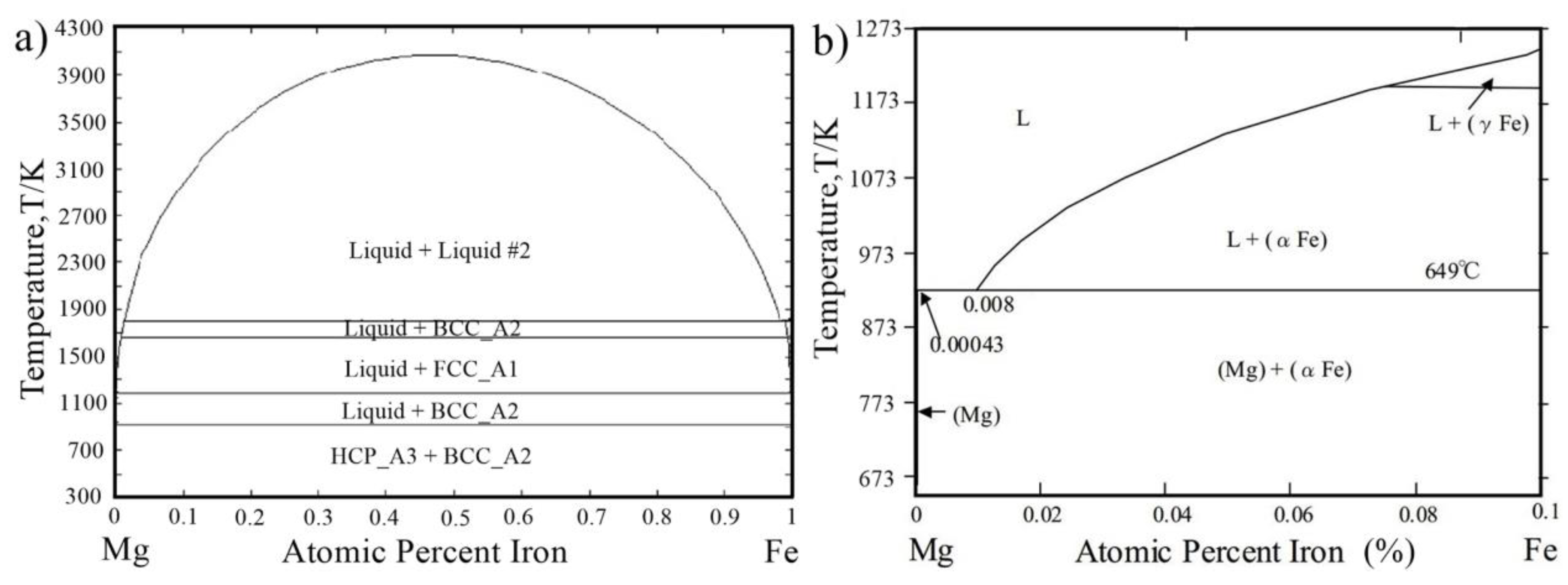
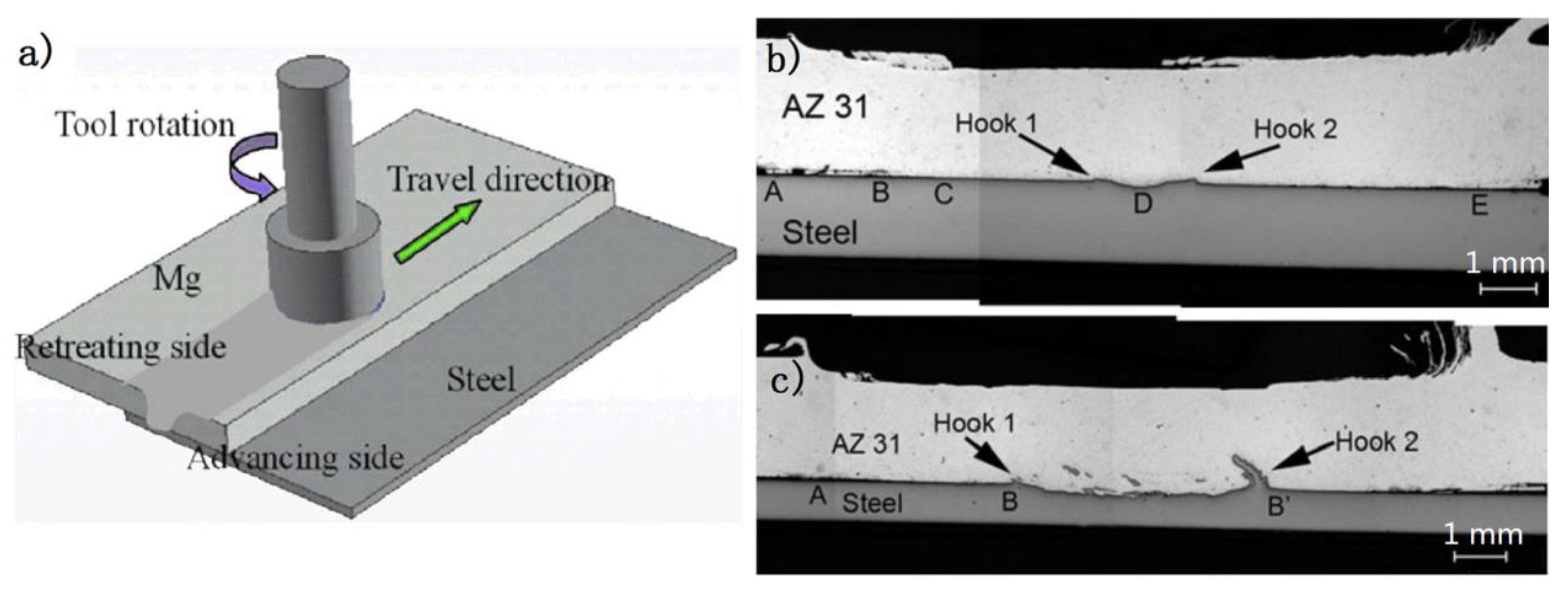
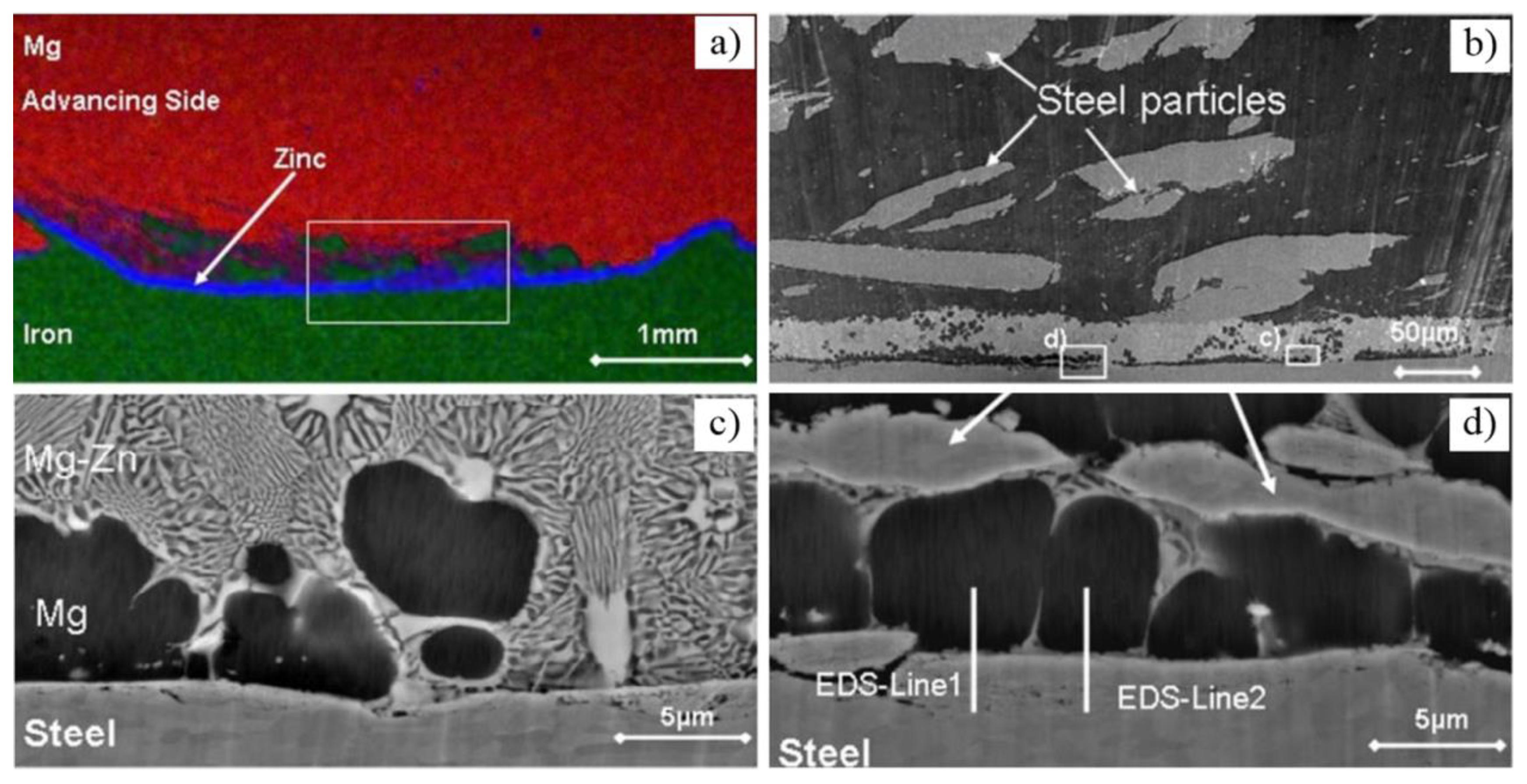
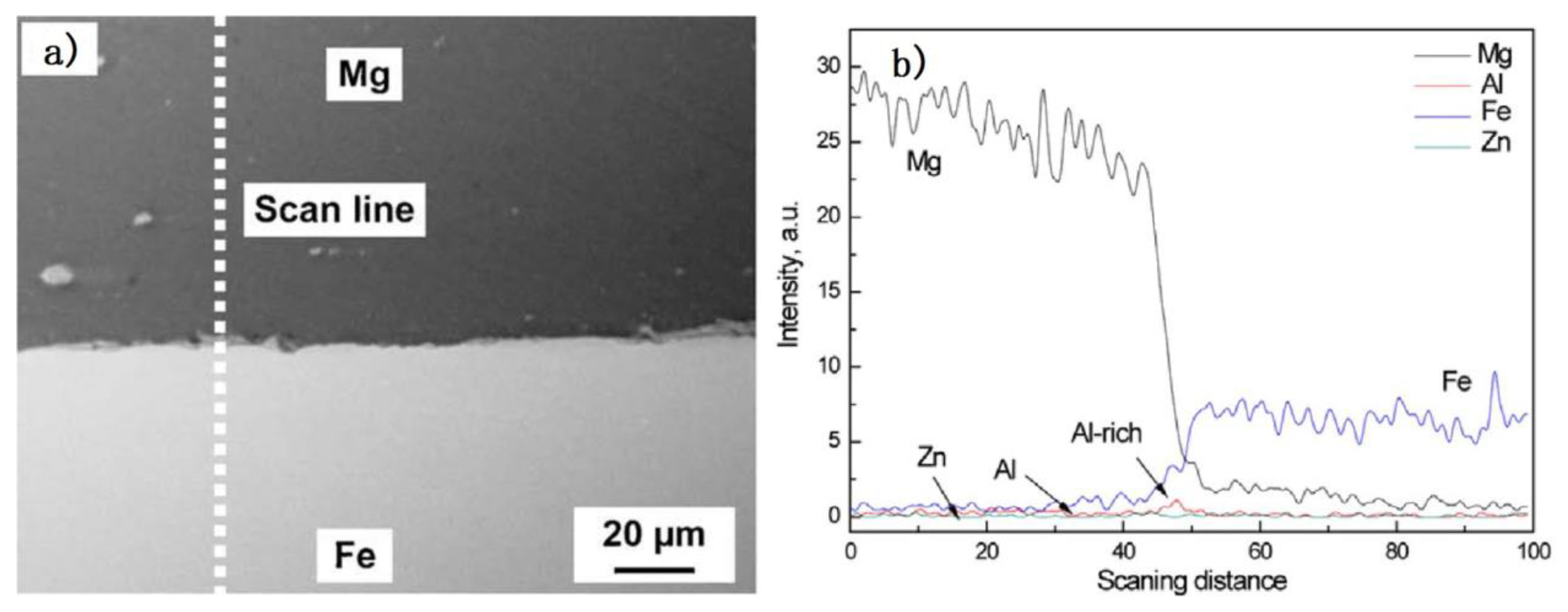
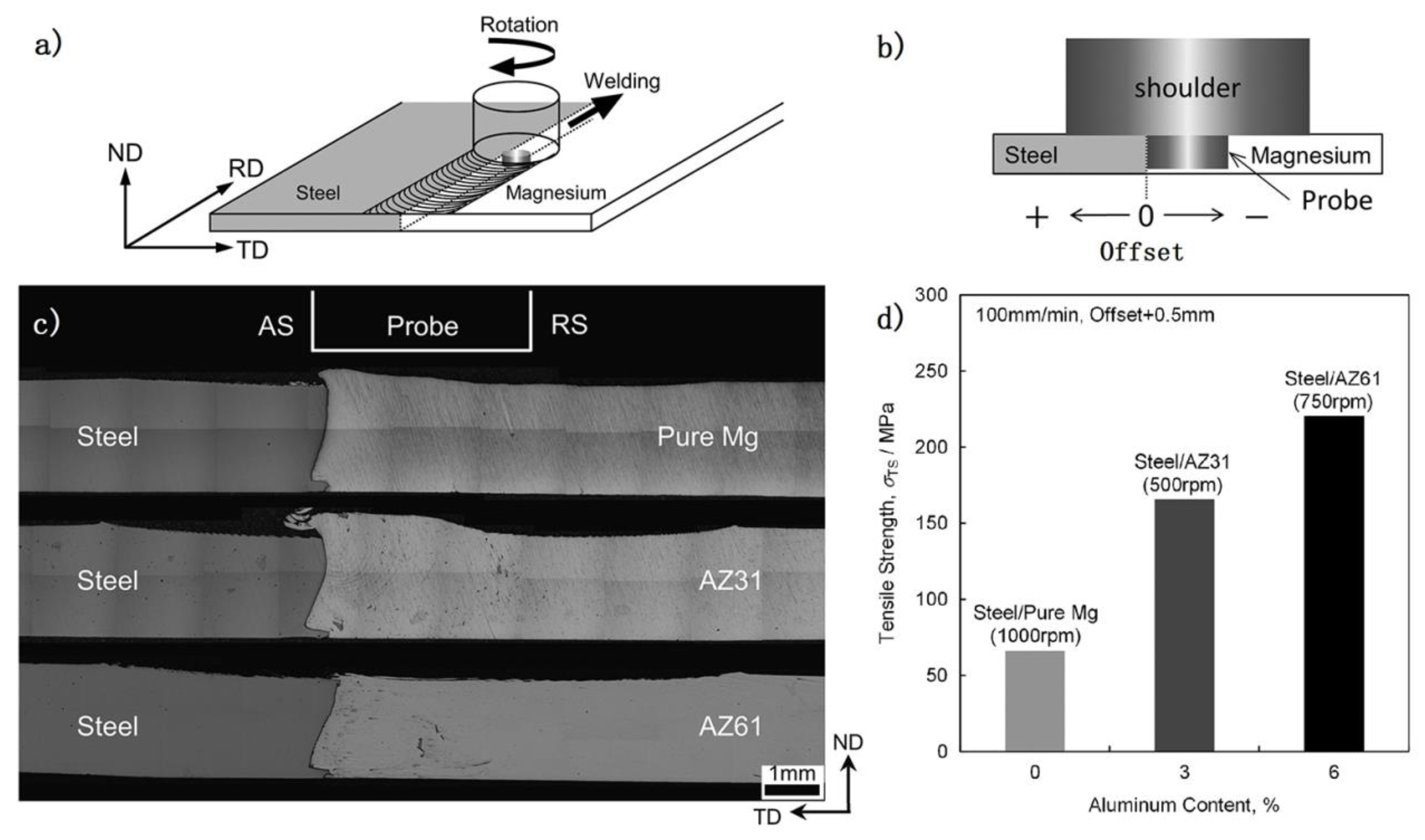
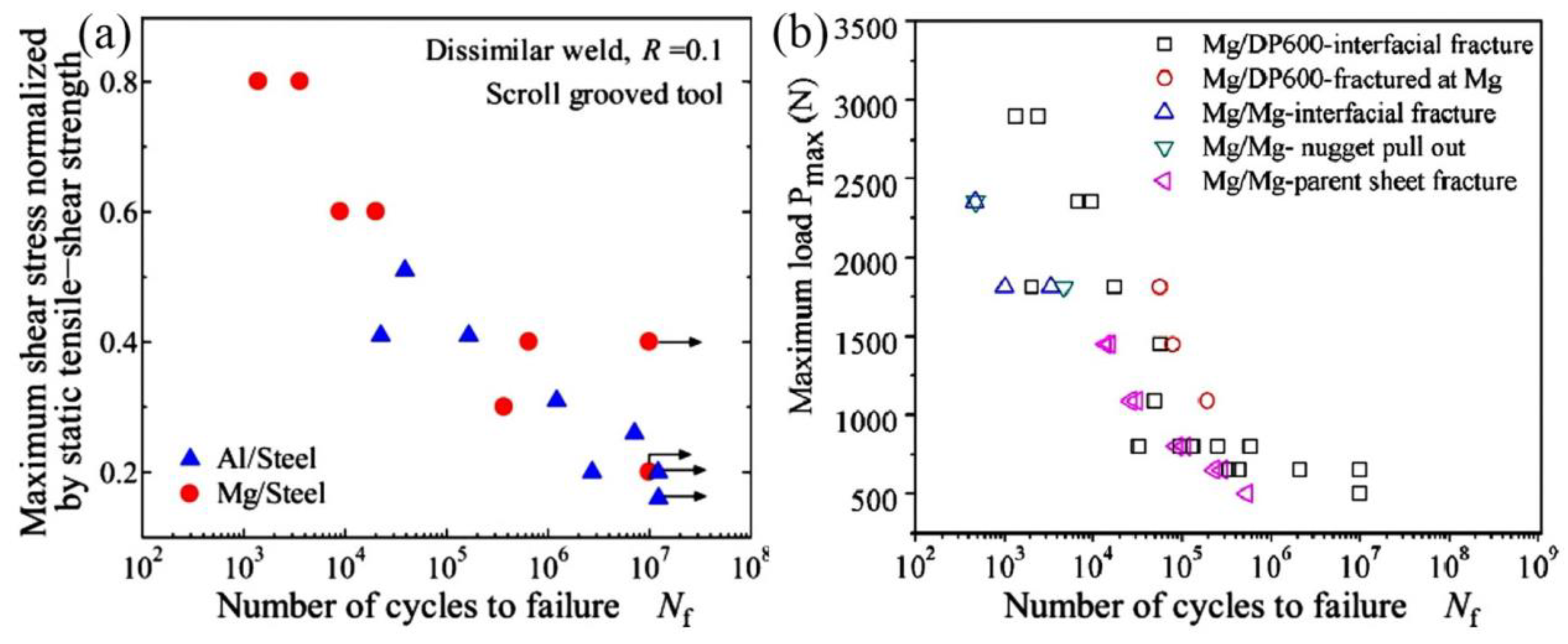





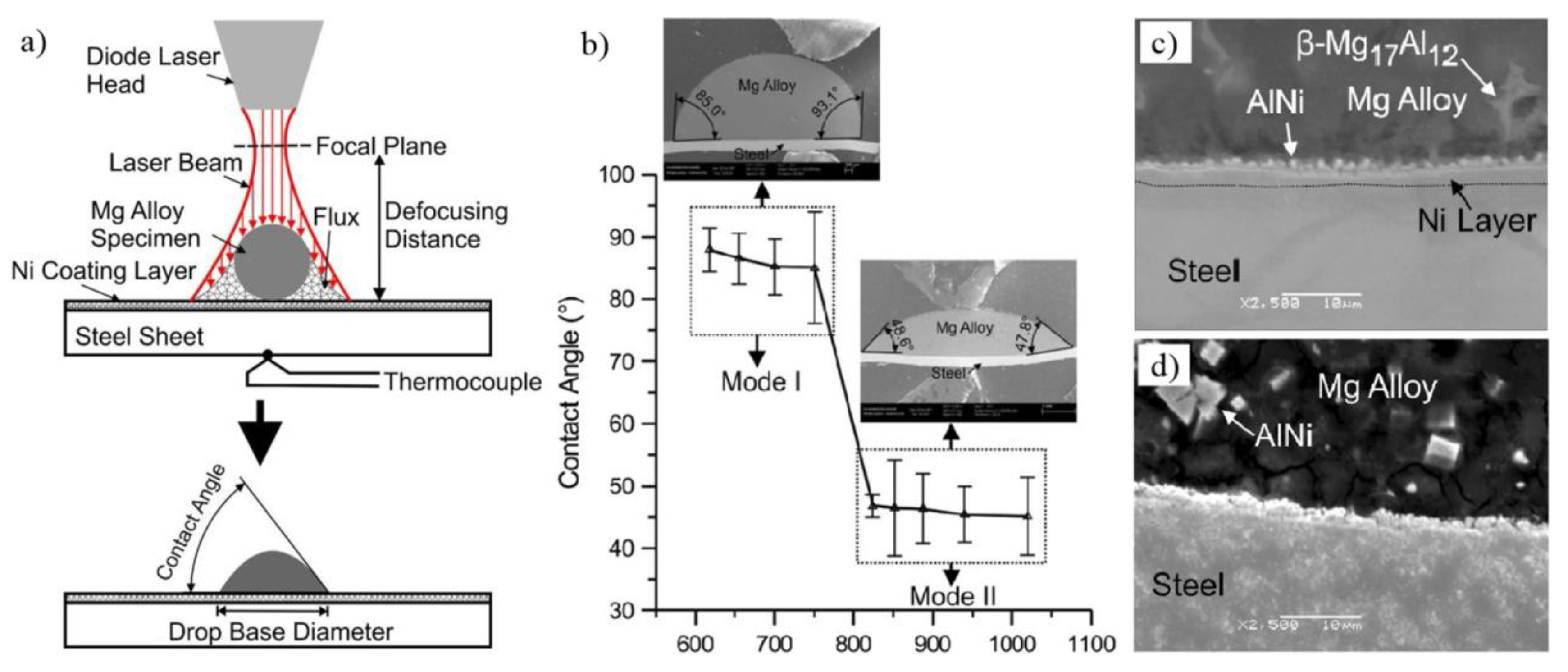

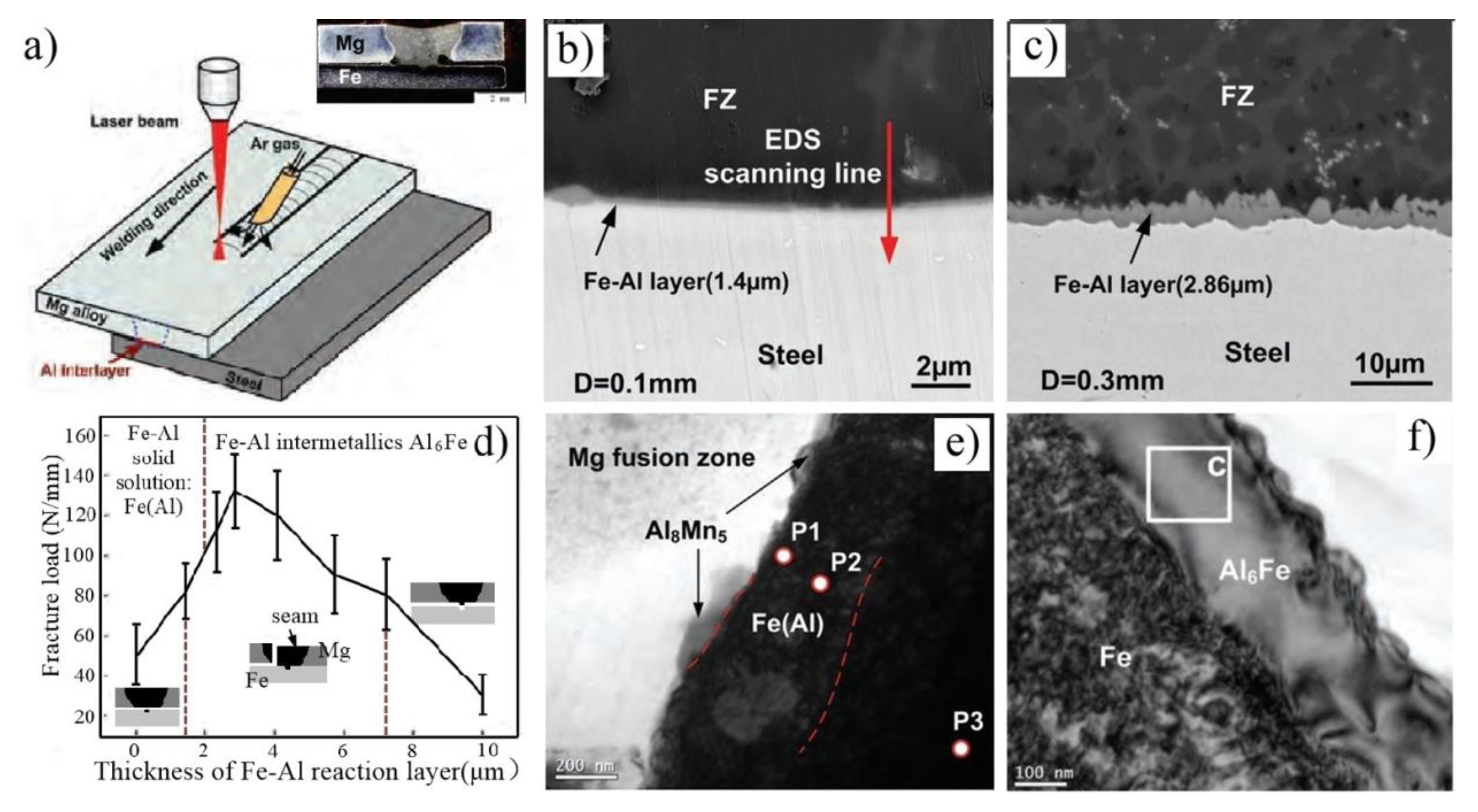

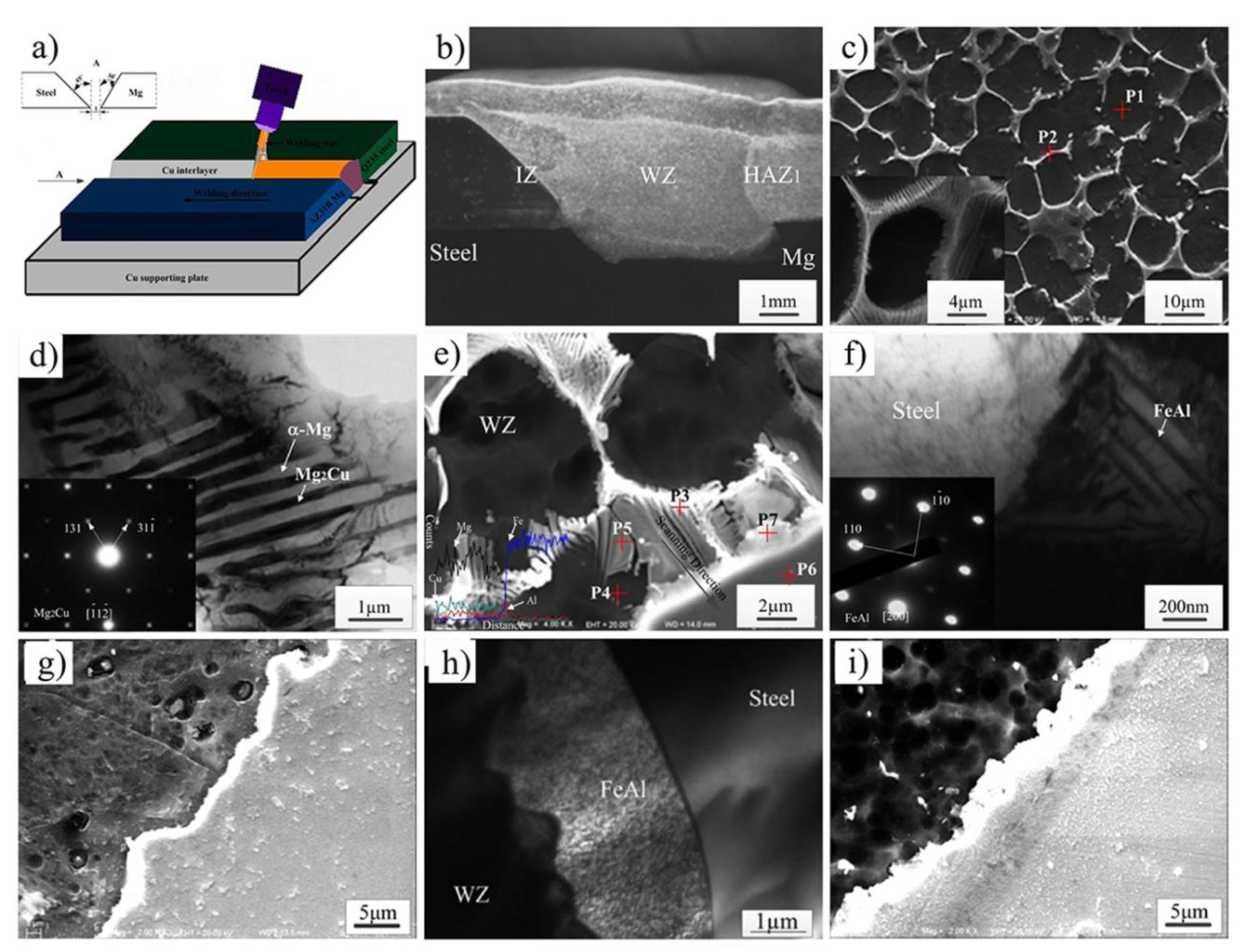



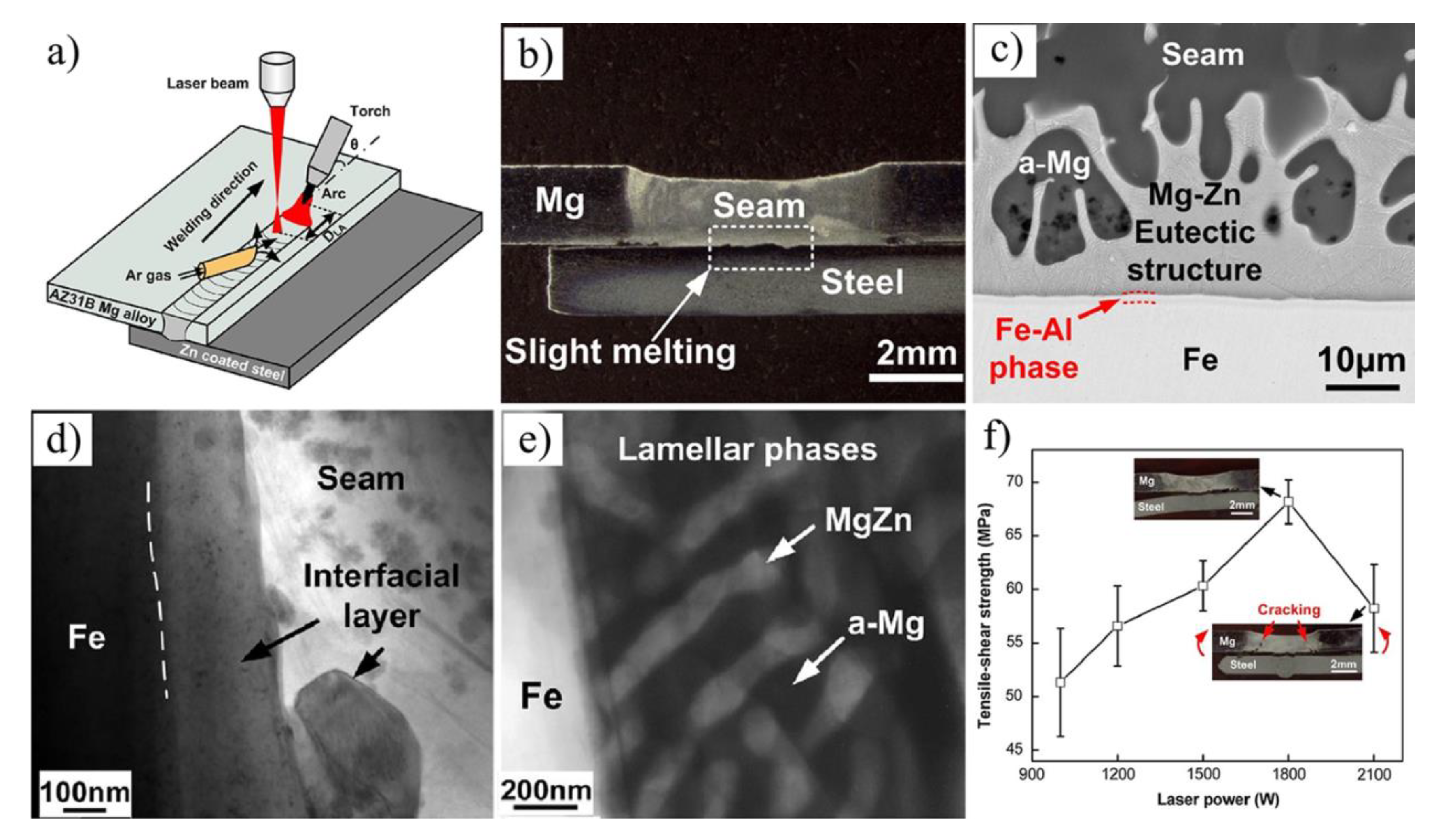
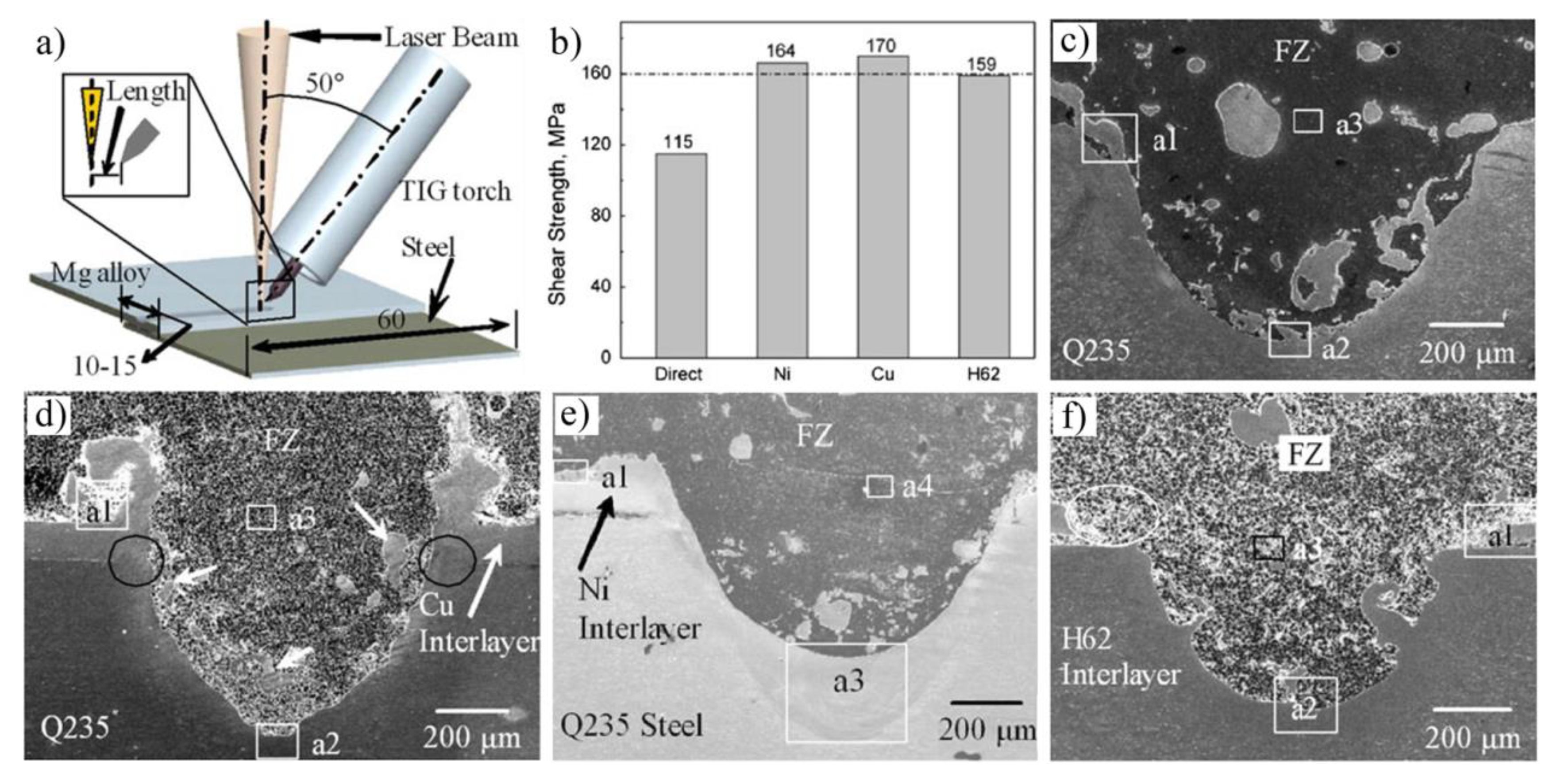

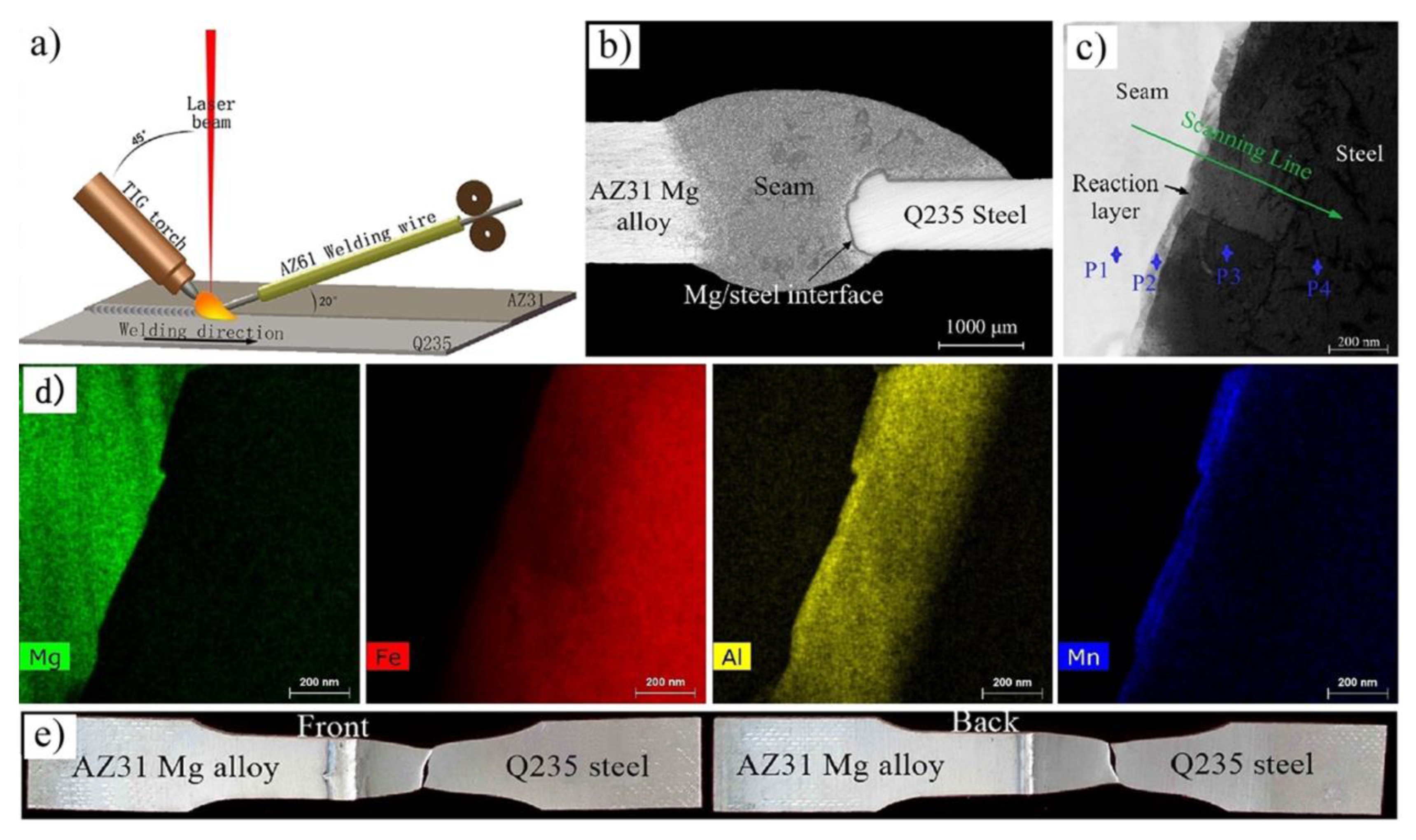
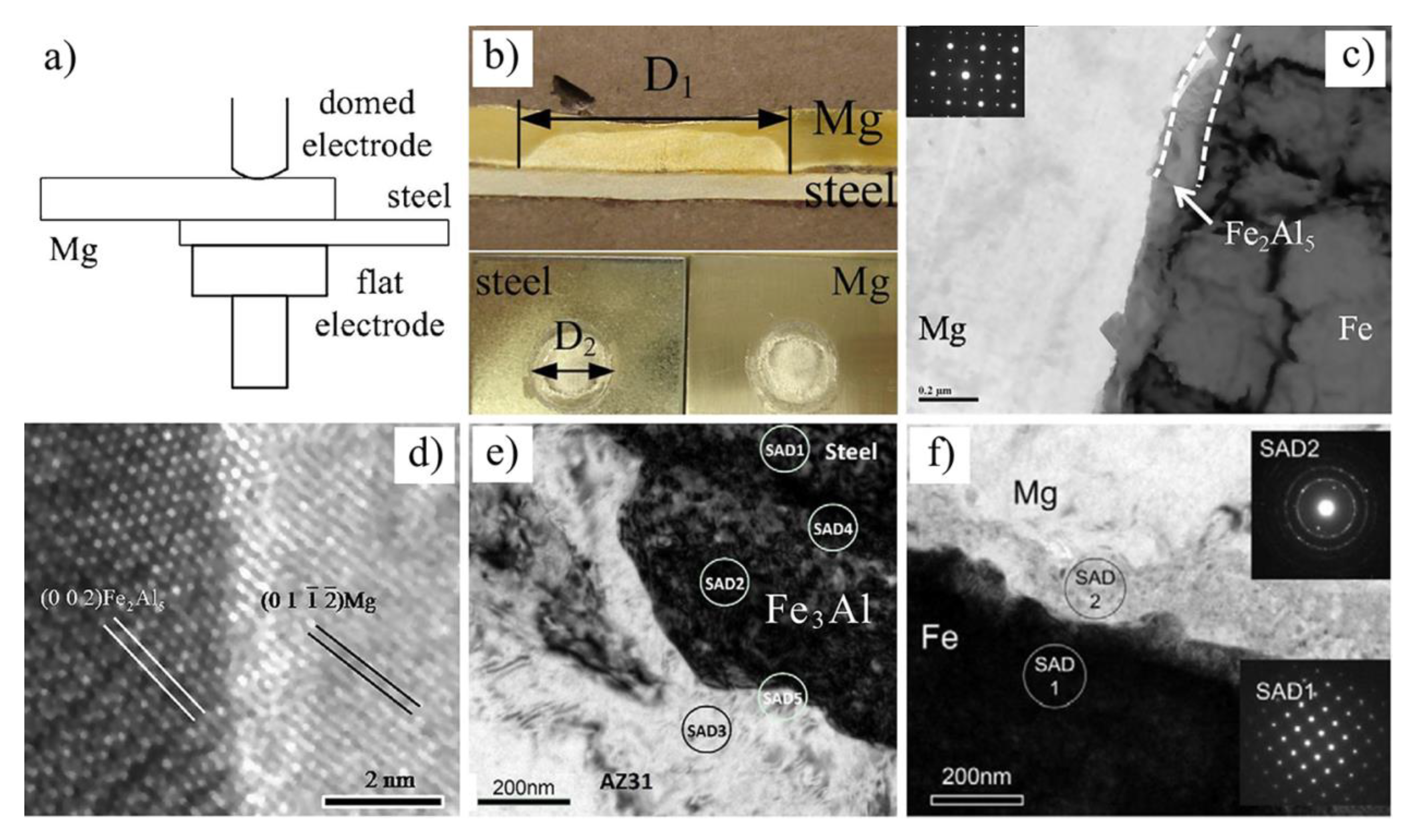
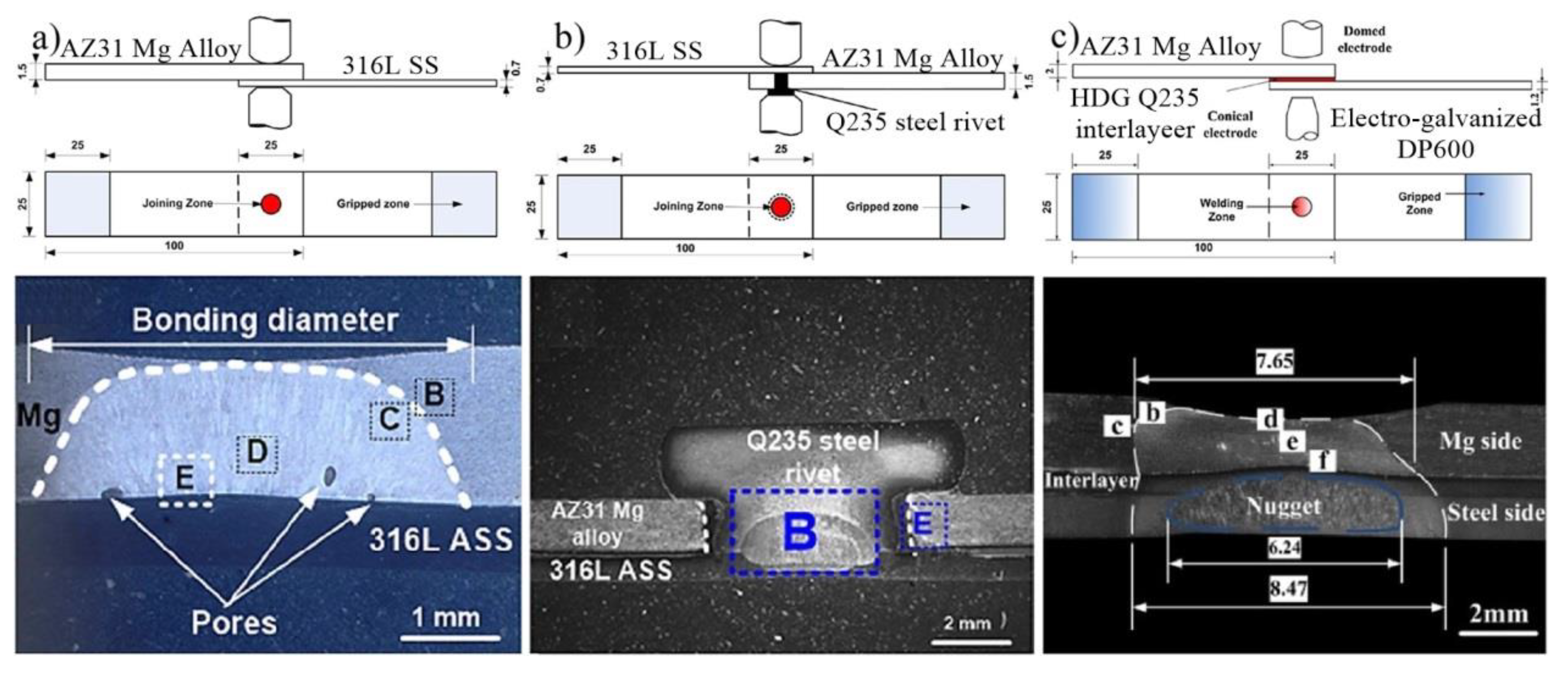
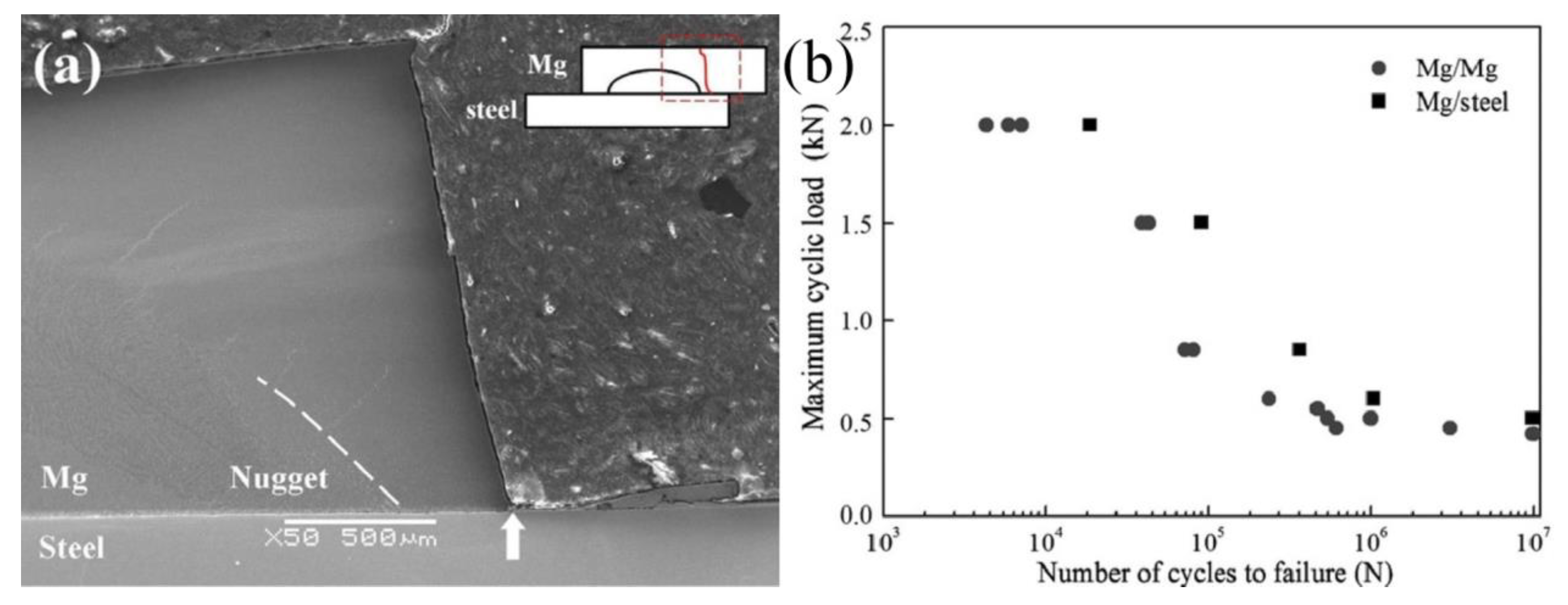
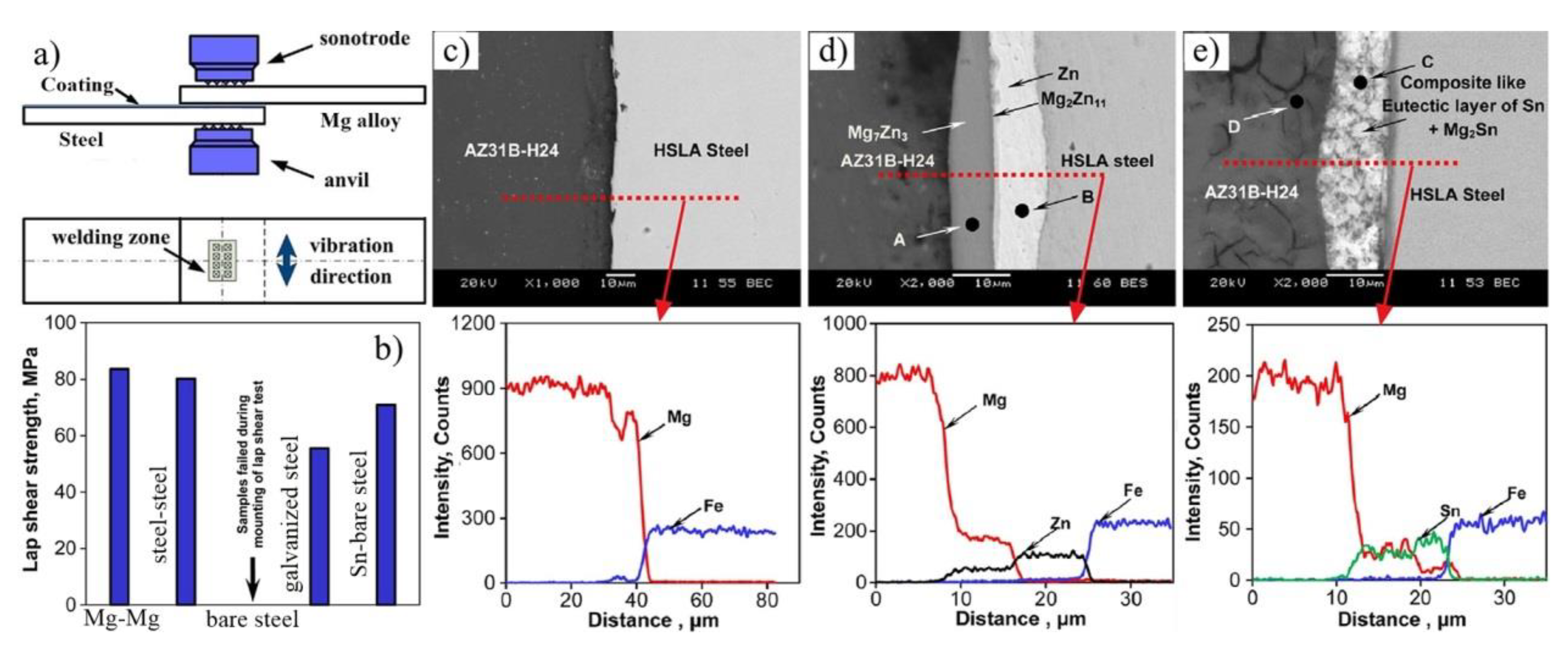
| Properties | Mg | Fe |
|---|---|---|
| Crystal structure | hexagonal close-acked | body-centered cubic and face-centered cubic |
| Atomic radius (pm) | 160 | 126 |
| Melting point (K) | 923 | 1811 |
| Boiling point (K) | 1363 | 3134 |
| Thermal conductivity (W/(m∙K)) | 156 | 80.4 |
| Young’s modulus (GPa) | 45 | 211 |
| Thermal expansion (μm/(m·K)) (at 25 °C) | 24.8 | 11.8 |
| Density (g/cm3) | 1.738 | 7.874 |
| Heat of vaporization (kJ/mol) | 128 | 340 |
| Heat of fusion (kJ/mol) | 8.48 | 13.81 |
© 2018 by the authors. Licensee MDPI, Basel, Switzerland. This article is an open access article distributed under the terms and conditions of the Creative Commons Attribution (CC BY) license (http://creativecommons.org/licenses/by/4.0/).
Share and Cite
Song, G.; Li, T.; Yu, J.; Liu, L. A Review of Bonding Immiscible Mg/Steel Dissimilar Metals. Materials 2018, 11, 2515. https://doi.org/10.3390/ma11122515
Song G, Li T, Yu J, Liu L. A Review of Bonding Immiscible Mg/Steel Dissimilar Metals. Materials. 2018; 11(12):2515. https://doi.org/10.3390/ma11122515
Chicago/Turabian StyleSong, Gang, Taotao Li, Jingwei Yu, and Liming Liu. 2018. "A Review of Bonding Immiscible Mg/Steel Dissimilar Metals" Materials 11, no. 12: 2515. https://doi.org/10.3390/ma11122515





